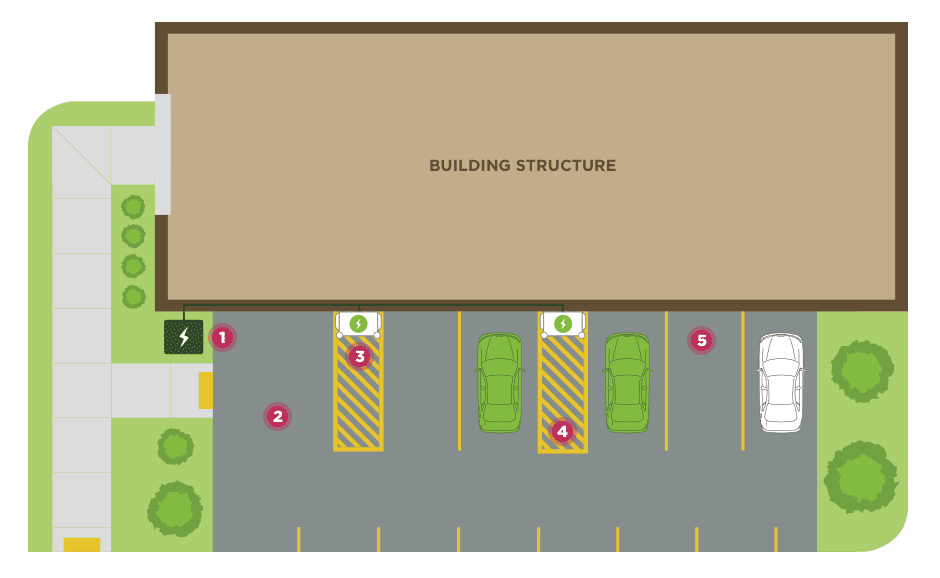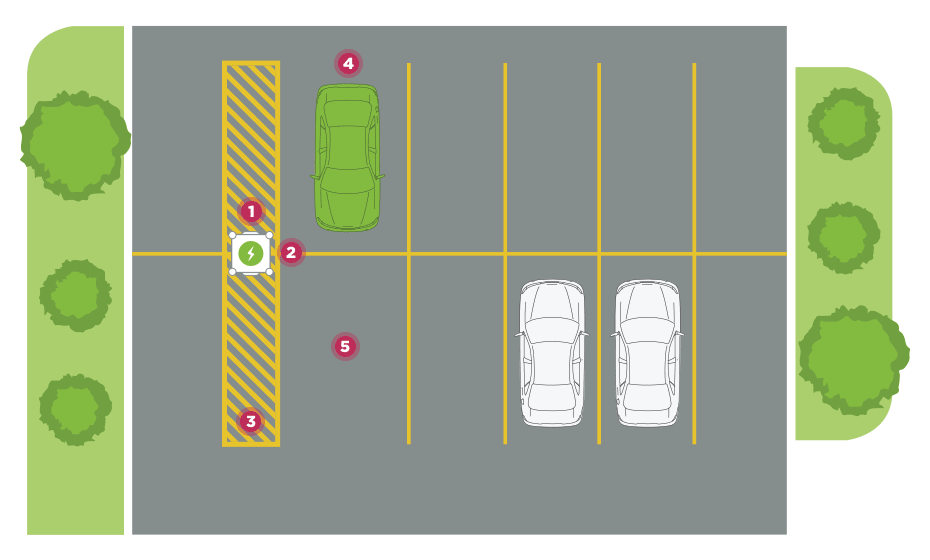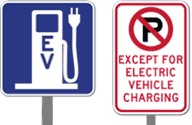Charging Installation Guide
Most electric vehicle (EV) owners do their charging at home overnight. However, charging at workplaces offers an extensive array of benefits for owners, employees, and customers - as well as many more charging equipment options to choose from. This guide to EV charging provides detailed information on commercial installation applications, as well as some notes on residential installation.
Drive Electric Charging Equipment Guide
Workplace and Commercial Charging
A mix of Level 1, Level 2, or even DC fast charging units is often recommended to meet different users at the lowest overall cost.
There are a variety of options available for EV charging equipment installations, from standard 120 volt outlets (often adequate for workplace charging) to specialized equipment with higher power flows for faster charging.
The equipment ranges in cost from $500 to $20,000 or more depending on the capabilities and amount of power provided. Higher powered units can reduce charge times from several hours down to 30 minutes or less.
Need a Primer?
Visit the electric car technology and charging equipment page for a general overview of EV charging technology.
Planning Workplace and Commercial Charging Stations

Select A Site
Is this charging installation for employees, visitors/customers, and/or the general public?

Calculate Costs
Determine installation costs and whether you need to recover costs.

Plan Your Site
Find out more about typical site plans, accessibility requirements, signage and other considerations.

Drive Electric Charging Equipment Guide
Select a Site
It's all about location, location, location.
Location Selection
Location depends upon the type of equipment. For example, long duration Level 1 charging may be a good match for home or workplace locations, but is generally not recommended for shorter duration parking areas, such as grocery stores.
| Level 1 (120V) | Level 2 (208/240V) | DC Fast Charging | |
|---|---|---|---|
| Typical Duration of Charge Event | 6-10 hours | 1-3 hours | 30 minutes |
| Range per hour of charging | 5 miles | 10-20 miles | 75+ miles |
| Typical Users/Uses | Home use Employee parking during the work day Long term (8+ hours) parking at a commuter lot, charging while on a carpool, walking or transit trip | Home use for EV owners wanting a faster charge Charging in a commercial area while shopping or doing business Parking at a commuter lot and charging while on a carpool, walking or transit trip | Fast charging while on a long trip in order to reach a destination or extend the length of a trip |
| Desirable Characteristics | Workplaces Lit, safe area Pedestrian and transit connections | Shopping, dining, restrooms etc. within walking distance Transit service Pedestrian facilities Lit, safe area | Amenities at the charging site (food, coffee, Wi-Fi) Lit, safe area |
| Priority Locations | Employee parking areas Long term customer/visitor parking Park and ride lots | Municipal or private parking lots in downtowns, village centers, growth centers or shopping centers | Near high volume roadway access points |
Top Four Site Considerations

Mounting
Wall mount units generally have lower capital and installation costs, so this option is often preferred if the site has a suitable wall area.
Dual port or multi-unit mounting options available from several EV charging equipment vendors may also help reduce overall installation costs as the incremental cost of adding another port is frequently much lower than installing an additional single port unit.

Constructability
This includes the extent of site work, such as trenching for underground conduit runs which many installation locations will require.
Where digging is required it is best to go through softer features, such as grass medians, rather than sidewalks, asphalt or areas with extensive landscape features.

Availability of Power
Proximity to electric power is often the key factor in determining installation cost. Placing charging equipment near existing power connections will reduce cost and installation time, particularly if there is reserve capacity available to avoid electric service upgrade costs.

Environmental Protection and Safety
Exposure to the elements should be minimized when possible. Charging equipment is engineered to be safe in wet environments, but areas prone to flooding or standing water should be avoided.
Additional Site Considerations
Workplace and Commercial Locations
After home, workplaces are the second most common location for electric vehicle charging. Several additional siting factors should be considered for these areas.
Parking capacity - Vehicles may need to sit several hours while charging. Placing charging equipment in areas with excess parking capacity and restricting parking in front of the charging equipment to charging vehicles only will reduce potential conflicts.
Proximity to employment / destinations - Since EV charging requires time it is advantageous to co-locate in areas with services, such as shopping, restrooms, food and other workplace facilities which provide EV owners with a range of activities to pursue while their vehicle is plugged in.
Modal Connections - Locating next to other modes of transportation, such as sidewalks, bus stops, and park & rides provides owners with access to additional destinations and opportunities.
Public locations
Public EV charging locations generally require the same considerations as Workplace / Commercial locations (above).
Factors particularly relevant to public locations include signage to direct users to the charging equipment, parking restrictions to increase the availability of charging installations, and consideration of fee collection systems to recover costs from users.
Recommended Equipment Specifications
Nearly all vendors in the United States meet the general recommendations for all charging equipment, including:
For public charging stations, additional specifications are recommended, including:
- Compliance with Society of Automotive Engineers (SAE) J-1772 standard for EV charging plug connector and operational requirements;
- Certified by a Nationally Recognized Testing Lab (e.g. Underwriters Laboratories) for outdoor use;
- NEMA Type 3R or 4 certification for outdoor electrical enclosures;
- Ability to operate in extreme temperature conditions (-20 to +100 degrees F);
- Americans with Disabilities Act (ADA) accessible buttons and components;
- A minimum 1-year warranty covering parts and service labor.
- Charging amperage from 30-80 AMPs to support vehicles with higher charging power capabilities (7.2 - 19.2 kW);
- Modular field serviceable parts, particularly for cord and J1772 connector, including a minimum cord length of 18 feet and a cord management system to keep cords off the ground and comply with National Electric Code (NEC) article 625;
- Network monitoring capability for status (e.g. in-use, malfunction, etc.), fault reporting, power consumption and usage patterns;
- A fee collection system using credit cards, access codes, phone operation and/or contactless RFID cards from widespread charging network(s) with customer service assistance available 24 hours a day, 7 days a week by phone.
Charging Equipment Availability
Equipment for EV charging unit installations is generally available directly from manufacturers, through local distributors or online. Larger installations are often bid out through a competitive process to obtain the best pricing possible based on unique specifications and requirements for a particular location. Several vendors offer "turnkey" services which include equipment selection, site planning, permitting and installation.

Drive Electric Charging Equipment Guide
Charging Stations Costs
Determine how or if you will recover any of your costs, such as charging fees at time of use or fees included in power expenses.
Installation Costs
Costs of EV charging equipment installation vary widely depending on site characteristics, and the quantity and type of equipment. As EV charging equipment has become more prevalent, prices and installations costs have decreased.
| Level 1 AC - 1.4 kW | Level 2 AC - 3.3-6.6 kW | Level 3 DC - 25-50 kW | |
|---|---|---|---|
| Equipment Price | $30 - 9001 | $600 - 9,000 | $15,000 - 60,0002 |
| Installation | $200 - 450+ | $2,000 - 12,000+ | $10,000 - 25,000 |
| TOTAL | $230 - 1,350+ | $2,600 - 21,000+ | $25,000 - 85,000 |
Estimates of per unit costs for charging equipment likely to be seen in Vermont over the next 5 years.
1 Prices vary with system capability to monitor and charge for use. Source Link. Accessed 13 March 2013.
2 Fuji Electric DC Quick Charger. Source Link. Accessed Web 11 March 2013.
Additional Installation Costs
Providing electrical service can account for 40% or more of the installation cost. One way to reduce this is to install equipment during new construction or lot resurfacing. Installing multiple charging stations at once can also dramatically reduce per unit costs.
- Power connection, including electric circuit components and conduit-runs necessary to reach the equipment;
- Mounting. Wall-mounts are generally less expensive than post-mounts which require concrete pedestals;
- Protective devices, such as bollards or wheel stops;
- Wayfinding signage, parking lot lines, and stripes;
- Lighting and internet connection if cellular data service is not available;
- Permitting expenses.
Operating Costs
| Level 1 AC - 1.4 kW | Level 2 AC - 3.3-6.6 kW | Level 3 DC - 25-50 kW | |
|---|---|---|---|
| Energy |
$200/year to $800/year: Energy costs will vary depending on time of use and total use. |
$200/year - $2,500/year: Energy costs will vary depending on time of use and total use. |
Highly variable depending on use and potential peak demand charges, which could reach $12,000/year for a 50 kW DC Fast Charger |
| Usage monitoring and point of sale systems (optional) |
$400: One time cost for a monitoring and payment system device. |
$255/year: per charging port for access to software and network systems |
$255/year: per charging port for access to software and network systems |
| EV Charging Unit Maintenance | $400/year | $400/year | $400/year |
| Snow Removal | Varies | Varies | Varies |
| Insurance | Varies | Varies | Varies |
| TOTAL | $600+ | $1,200+ | $1,500+ |
Estimated operational costs of EV charging equipment, including electricity, usage monitoring, point of sale services, insurance, and maintenance costs. Snow removal costs will vary widely depending on the design. Insurance costs to extend coverage to EV charging equipment will also depend on the owner's policy and coverage.
The most common maintenance issue is damage to the cords and/or J1772 EV charging equipment plug connectors. Most manufacturers have modular equipment designs that allow for swapping out damaged parts. However, UL requirements sometime dictate replacing entire sealed modules rather than individual components to maintain certification.
Cost Recovery and Profit
Several EV charging business models are summarized in the table below. The potential for profitable operation of charging stations in Vermont depends on demand for the service by EV owners. Based on current ownership levels there are few locations in Vermont which could achieve profitability in the near term without using a combination of the models listed below.

Subscription and Fee for Use
EV charging equipment owner charges a fee based on a flat rate per session or hours connected to the charging equipment. Monthly subscriptions are also possible. Several manufacturers of charging equipment include options to collect user fees in real time.
The most common models for charging users is through a membership or pay-per-use fee. Vermont and many other states do not currently allow unregulated utilities to sell electricity by the kilowatt-hour. Legislative changes have been proposed to provide an exception to this rule for EV charging, but until enacted billings would need to be done based on time connected to an EV charging unit or through unlimited access for a fixed monthly fee.

Advertising-Based Revenue Generation
Some models of EV charging equipment are designed to provide space for advertising messaging which the owner could use or lease out. This use of advertising may require specific review by local jurisdictions in the permitting process.
Vermont's Billboard Law restricts signs in the highway right-of-way, limiting the potential sale of advertising on EV charging equipment located on highways and roads. For EV charging equipment located out of view of highways and roads, advertising signage may be a viable means of collecting revenue.
For example, Price Chopper has pioneered this model in New York state with its "Alternative Fuel Pads", charging stations equipped with a canopy and space for advertisers. The model works through direct ownership-as in the case of Price Chopper-or through third-party ownership. In a third-party ownership model, a vendor would install and operate the EV charging equipment on the premises of the host.

Solar Photovoltaic Installations
Solar Photovoltaic installations can offset energy costs of EV charging through utility net metering arrangements.
Vermont's Net-metering and Standard Offer laws allow owners of grid-connected PV to generate a credit from the production of electricity and apply it to a utility account. The credit covers the customer's current rate, plus an additional "solar adder" calculated as $0.20 minus the utility's highest residential rate. This premium applies for the first 10 years of operation, after which the credit is valued at the utility's highest residential rate.
Renewable energy professionals can help you navigate the most cost effective means of using renewable energy for your business and EV charging needs.

Drive Electric Charging Equipment Guide
Site Planning and Property Needs
If you do not own the property then discuss the process with the property owner and receive approval before you take next steps.
Typical Site Plans
There are many possible configurations when it comes to designing EV charging stations. We recommend at least one EV charging parking spot be available to people with disabilities at a given location.

Wall Mounted Site Plans
Electric Vehicle charging equipment mounted to exterior walls adjacent to parking spaces is often the most cost effective location for charging equipment. The site plan diagram above shows a sample installation with several points to consider when installing charging equipment.
- Minimizing the distance from electrical power connections to the charging equipment will keep installation costs down.
- Electric Vehicle Charging Only signage is recommended to reduce conflicts with parked vehicles that do not need to use the charging station.
- Consider cord management options from charging station vendors to keep cords off the ground and within easy reach of all users.
- Disabled users will need a minimum clear space in front of the charging equipment of 30 x 48 inches to allow maneuvers in wheelchairs or other mobility devices. The mounting height of the equipment should provide for all operation needs between 24-48 inches off the ground.
- Protect the charging equipment with bollards or wheel stops to prevent accidental damage.

Perpendicular Parking Spaces
Perpendicular parking is the most common configuration for workplaces and public EV charging
Above is an example layout of a parking lot with stall dimensions of 9 feet wide by 18 feet long. A five foot wide aisle provides room for disabled users to maneuver.
Locating the EV charging equipment in the middle of a group of parking stalls allows vehicle owners to reach their vehicles in several parking spaces to reduce the possibility of getting blocked by a vehicle which is not charging.
- Mounting charging equipment in between parking rows will maximize the number of spaces the cord can reach.
- Consider snow removal needs when protecting charging equipment with bollards or curb stops.
- Providing a 5 foot wide access aisle between parking spaces is needed to allow disabled users to travel between vehicles.
- Manufacturers place charging ports at different locations around the vehicle, so flexibility in parking and adequate cord length (at least 18 feet) is recommended.
- The first charging station parking space should be ADA accessible for van users.
Learn More
See the Electric Vehicle Charging Station Guidebook for more information on siting EV charging equipment.
ADA Requirements
For EV Charging on Public Sites
The Americans with Disabilities Act (ADA) requires public parking areas to be accessible to people in wheelchairs or with other mobility limitations. While the U.S. Access Board has not specified ADA requirements for EV charging stations, general accessibility requirements for parking areas and public facilities do apply.
To manage accessibility requirements, many charging station hosts make the first charging space accessible by adapting an existing handicap spot. At this time, it is not be necessary to restrict use of accessible EV charging to disabled users only.
For more information on accessible charging stations read the following reports:
ADA & Public Charging Reports
Further Considerations
Snow Removal
In order to provide accessible operation of the EV charging equipment, a 3-foot by 3-foot (minimum) handicapped accessible operating area must be kept clear of vehicles and snow between the nose of the vehicle and the EV charging equipment. Here are some methods of doing so:
- Canopies or roofs to keep the operating area clear of snow and reduce weather-related damage.
- Heated pavement to keep the EV charging equipment operation areas free from snow and ice with available power.
- Retractable cables that provide access to the EV charging equipment cable with minimal snow removal. Many EV charging equipment designs require users to manually wind and replace the cable after use. This may become difficult in cold weather when the cable becomes stiff, and may result in the cable being placed on the ground.
Signage for Charging Stations
While many EV users can now find charging locations through their smart phones or onboard navigation systems, there is still a need for clear roadside signage for EV charging equipment. Many users may be tourists, and signage will help alleviate anxiety about finding a charging location.

General Service Signs - The Manual on Uniform Traffic Control Devices (MUTCD) has adopted a standard blue service sign symbol for EV charging stations.
Regulatory Signs - The recommended practice in Vermont is to use language restricting parking "Except for Electric Vehicle Charging" to prevent instances of EV owners taking up charging spaces without actually plugging into the equipment.
Final Steps to Implementing Charging Equipment
The same steps apply to public and private EV charging stations.
1. Select the site and develop a plan
- Consult a licensed electrician or hire a turnkey service provider to handle the installation process
- Secure the necessary state and local permits
2. Construct the facility
3. Install and commission the equipment
4. If desired, notify Drive Electric Vermont to be added to the map of public charging stations.
5. Operate and Maintain
Drive Electric Charging Equipment Guide
Charging for Home Owners
Learn about charging at home.
Charging Equipment Installation
Single Family Charging
Charging at home is by far the most popular option for EV owners. Many people choose to charge their vehicles overnight when it is most convenient and electric rates can be lower if you are on a time of use plan offered by several Vermont utilities. Homes often have ready access to power connections, reducing EV charging equipment installation costs. Existing 120V outlets can be used for Level 1 charging, using equipment supplied by vehicle manufacturers who generally recommend using a 15 Amp circuit with GFCI protection. Several varieties of level 2 equipment are available with 240V plug connections which can also reduce installation costs if buildings have existing outlets in garages or near vehicle parking spots.
Multi-Unit Charging
Charging stations in multifamily residences may present challenges in terms of access and competition, particularly if there are not dedicated spots for EV charging. Some communities are considering requirements for homeowners associations or landlords to allow residents to charge their vehicles when feasible. Please contact Drive Electric Vermont if you live in multi-unit housing and are not able to charge - we'll do our best to help out.
Why Install a Charging Station?
A summary of the rationale and process for residential charging stations:
| Single Family Home Owners | Multi-Family Owners & Tenants | |
|---|---|---|
| Why Do It? | Faster and more convenient charging for EV owners | Allow homeowners/tenants to charge their EVs at home |
| How Does It Work? | Usually just need one charging station in garage or driveway area on your property EV charging is treated just like an electric appliance | Treated just like an electric appliance Configuring a separate meter from power company is the most straightforward means to charge costs back to EV owners Or, use charging equipment with built-in metering and set up agreements to recover costs |
| Installation Plan | Select a location, ideally close to existing power supplies. Outlets with suitable specifications can be used with no additional wiring. Select equipment or work with contractor to choose Check municipal permit requirements Hire electrical contractor or complete the installation yourself | Survey residents to estimate demand Select location(s), ideally close to power source Select equipment or work with contractor to choose Receive approval from property owner, condo association, etc Check municipal permit requirements Hire electrical contractor to complete installation |
Drive Electric Charging Equipment Guide
Additional Charging Station
Installation Resources
Electric Vehicle Charging Station Guidebook
Advanced Energy's Installation Guidebook
The Northeastern States Transportation and Climate Initiative Guidelines